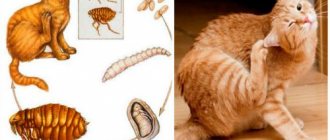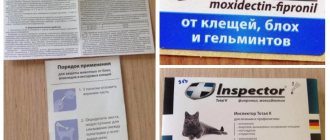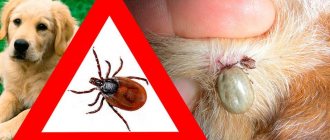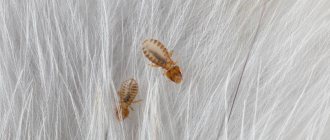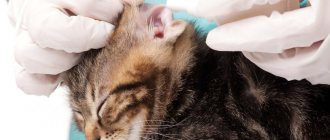Who are roundworms?
Roundworms are dioecious roundworms that are characterized by sex differences in size. Females are usually much larger than males. Most often, roundworms infect the gastrointestinal tract of cats, although some species can colonize the bile ducts and pancreas.
Cats are characterized by 3 types of roundworms:
- Toxocara leonine - females usually reach 10 centimeters in length, and males - 6 cm. The body has a yellowish tint. And the head section is equipped with lateral wings and has three lips. It has a simpler cycle, unlike Toxacara catti. The eggs are excreted from the body of the main host (cat or dog) along with the feces, within 4 days it “matures” - at this time the larva inside moults, thus the egg becomes active for infection. Then the eggs can directly enter the cat’s body, or by eating an intermediate host - a rodent. Not dangerous for people.
- Toxocara mystax or Toxacara catti - The main causative agent of ascariasis (toxocariasis) in cats. Males are usually much smaller than females - from 3 to 6 cm, while females are more than 10 cm. To reach sexual maturity, the parasite migrates in the cat’s body and spreads from the intestines to the lungs and liver, and also damages other organs. From the trachea, the larvae, when coughed, again enter the digestive tract and complete the cycle. Dangerous for humans.
- T. canis - affects not only dogs, but can also parasitize in the intestines of cats. The development cycle completely repeats that of the feline Toxocara. It is also dangerous for humans, although it does not undergo a full cycle in the body; humans are intermediate hosts.
The main danger of roundworms is their high contagiousness. When the soil is infested with eggs, they can persist for several years, becoming a source of disease.
Routes of infection and development of parasites
Toxocariasis, which is the name of the disease caused by roundworm larvae, is not rare. Throughout the country, thousands of cats suffer from this pathology. The main source of infection is already sick animals, which spread worm eggs along with their feces. The infection zone contains soil, plants, interior items, etc. The most “densely populated” place is the animal’s fur, which is where worm eggs are found in greater quantities. Because of this, roundworms also pose a danger to humans.
In addition, there are other ways of infection with roundworms:
- Intrauterine infection. The larvae of helminths that parasitize the body of a pregnant cat enter the kittens through the mother’s placenta.
- Accidental ingestion of eggs. A healthy pet can eat the parasite along with food or grass on the yard lawn.
- Infection from rodents. Almost all wild mice are infected with roundworms.
Mechanism of development of toxocariasis
Worms in an animal's body develop from larvae.
Ascaris eggs, once in the cat’s intestines, go through several stages of development:
- The shell of the egg dissolves under the influence of digestive enzymes, and only a microscopically small larva remains, which digs into the intestinal walls.
- Entering the bloodstream through the intestines, the larvae begin to scatter throughout the body.
- The final destination is the lungs. It is there that the larvae increase significantly in size and move into the bronchi.
- They enter the oral cavity along with a cough, after which they are swallowed again.
- Once back in the intestines, roundworms reach sexual maturity.
Roundworms go through several stages of development in a cat's body.
From the beginning to the end of the cycle it takes about a month.
Causes
The main route of transmission is through soil, food, grass, and furnishings contaminated with worm eggs.
The main route of transmission is through soil, food, grass, and furnishings contaminated with worm eggs. Parasites can get on the animal's fur and settle in the intestines through licking.
Another alternative route of infection is an intermediate host. In them, roundworms cannot reach sexual maturity and are encapsulated in the nervous system and muscles. A cat becomes infected by eating an infected animal. Rodents, earthworms, frogs, pigs, birds and sheep can act as intermediate hosts.
If the female is pregnant, then infection of the offspring occurs through the umbilical vein directly into the lungs. There, the parasites enter the kittens' trachea, subsequently migrating into the intestines and completing the maturation process. This method of infection is typical for canine toxocara, while Toxacara catti does not infect the fetus.
Toxocara also infects offspring during breastfeeding, entering the intestines through milk.
One infected cat per day can excrete about 100,000 eggs in feces, which are contained in just 1 gram of feces.
What do parasitic worms look like?
Roundworms look like thick white laces
, it happens that they have a yellowish color. The size varies from a couple of centimeters to twenty centimeters. If the infection occurred a long time ago and no treatment was undertaken, then they multiply through the cat’s feces. Some white worms of decent size begin to swarm in the feces, which is considered the extreme stage of the disease and must be treated immediately.
How does infection occur?
The disease and the parasites themselves are common. Moreover, not only on the territory of Moscow, but also beyond its borders throughout Russia. Infection , oddly enough, occurs due to contact between a sick cat and a healthy one . To be more precise, a sick cat releases worm eggs into the environment through feces. They infect both furniture and the interior as a whole, as well as the ground, water, and so on. Even on the animal's fur there are larvae and eggs after the cat has licked itself. Thus, infection can occur from anywhere if the patient has had at least some contact with a healthy cat.
Symptoms
With ascariasis in cats, an increase in temperature is possible.
In adults, toxocariasis rarely causes symptoms of the disease. Mostly, signs of the disease appear in kittens. Typically characterized by stunted growth and lack of weight, an enlarged abdomen and dull coat.
The offspring also develop:
- Anemia, expressed in pallor of the mucous membranes and skin.
- Diarrhea and vomiting. Blood may be found in the stool.
- Possible increase in temperature.
- Itching of the anus, due to which the cat will constantly lick it.
Due to the migration of larvae, cats may experience complications due to damage to internal organs:
- Pneumonia.
- Ascites.
- Peritonitis.
- Cough (due to the release of larvae into the trachea).
- Liver damage.
If there are a large number of parasites, the kitten may develop intestinal obstruction, causing constipation. The bile ducts are also blocked, leading to obstructive jaundice.
How dangerous is ascariasis for cats?
Roundworms in cats cause the chronic disease toxocariasis. In principle, even the name “roundworms” for roundworms that parasitize the body of cats and dogs is not entirely accurate. Toxocara leonina, Toxocara mystax, Toxacara catti live in the intestines of cats and dogs. You can see how they look in the photo. These parasites belong to the general suborder of roundworms (nematodes) Ascaridata of the genus Ascaris. It has been clinically proven that roundworms of cats and dogs cannot cause helminthic infestation in humans.
Dog or cat roundworm eggs will not be able to develop in the human body, even if they are purposefully “planted” there. This is due to the fact that human roundworm develops in the intestines at a temperature of 36.6 degrees, and roundworms of cats and dogs develop at a temperature of 38.5 - 39 degrees.
A person can become infected with other worms from animals, so pets need to undergo a full course of deworming once every 3 months, and if a helminthic infestation is diagnosed, they need adequate treatment.
Is there immunity against worms?
Some animals are born immune to certain worms and similar parasites. Most likely this is due to a strong developed immune system, which fights parasites particularly effectively. However, this does not guarantee complete protection from external parasites.
The body's defenses are capable of squeezing out the parasite on its own.
, therefore, there is a possibility and probability that even after some symptoms and signs, they pass and the worms die.
The main thing to consider
– keeping a cat, feeding it, diet, as well as physical activity. Only such a pet is able to resist any diseases and parasites and, with a little help from medications, quickly come to its senses and, perhaps, even go through its entire life without a single disease.
Ways of infection of pets
Even if your pets are constantly at home, the possibility of ascariasis in cats cannot be ruled out.
Even if your pets are constantly at home, the possibility of ascariasis in cats cannot be ruled out. An animal may “just for a second” jump out onto the landing, or may sniff and lick your outdoor shoes, which almost always contain worm eggs.
Puppies and kittens can ingest eggs in their mother's milk or become infected in utero from a sick mother. Before mating, animals must undergo anthelmintic treatment.
With the feces of a sick animal, fertilized eggs of parasites fall into the soil, where, under favorable conditions, the maturation process occurs. Microscopic mature worm eggs are carried by flies, ants, and shoes. Gusts of wind during drafts, along with dust, can be carried into the apartment through open windows. It is noteworthy that in direct sunlight the eggs die within a couple of hours, but they can tolerate frost down to -25 degrees, just being on the surface of the earth.
Only regular wet cleaning, disinfection of trays, maintaining a sanitary culture of housing, regular deworming and proper treatment can protect pets from parasites.
Treatment of ascariasis in cats
To treat roundworms in cats, your veterinarian will prescribe anthelmintic drugs. They help get rid of parasites with a probability of 90%.
Important!
Self-administration of any medications poses a danger to special categories of animals - kittens and pregnant cats. Therefore, the specialist will draw the attention of the owner of the furry purr how and with what it can be treated. Anti-roundworm medications are prescribed to kittens from the age of 3 weeks. In pregnant cats, anthelmintics are possible in the second half of the term.
Among the popular drugs:
- Drontal tablets;
- Prazitel suspension;
- Azipirin tablets;
- Kanikquantel gel and tablets;
- Milbemax tablets.
If, while treating ascaris, the cat's owner notices changes in the pet's condition: it becomes lethargic, lethargic, and vomiting, you should immediately contact a veterinary clinic. An individual reaction to drugs may be noted.
Treatment of ascariasis in cats
In case of severe intoxication of the animal against the background of roundworm infection, droppers are prescribed under the supervision of a specialist. If a cat develops intestinal obstruction due to blockage of the lumen by lumps of worms, surgical intervention will be required.
Important!
Considering the prevalence of roundworms and the high frequency of infection, any kitten that comes into the house should be considered potentially sick and should be given anti-parasite medications even in the absence of an infestation clinic.
If helminths are detected in a cat, you should carry out a general cleaning of the house with chlorine-containing products, carefully treat all places where the animal could be, the bed, and bowls.
Are roundworms in cats transmitted to humans?
Quite often, when we see an infected animal, we reflexively scare it away, fearing infection. This is one of the most popular myths. The opinion that roundworms in cats are transmitted to humans turns out to be erroneous.
The fact is that round intestinal worms in animals do not take root in the human body. There is an opinion that large roundworms in the body of a pig can take root in humans, but this has not yet been proven by science. The very way of infecting a person with worms is as follows: viable eggs can enter the body only through the soil, and only from person to person.
How and why does infection occur?
Toxascariasis in cats is provoked by 3 types of toxocara - cati, canis and leonina. Parasites belong to the class of nematodes (roundworms) and reach up to 20 cm in length, have a color from pale yellow to light brown. On the head of the worm there is a mouth opening with teeth, with which the worm damages the mucous membranes and penetrates into the organ. Most often they parasitize in the small intestine. However, they can migrate with the bloodstream and settle in the lungs, brain, and organs of the genitourinary system. The most dangerous worms are in kittens under 3 months of age, when death can occur due to toxins secreted by the worms.
The cat swallows the egg, from which the larva hatches in the body. Invading organs, roundworms damage the mucous membranes, feeding on the beneficial substances of the cat's body. Infection in kittens occurs through a sick mother. Animals become infected in this way:
Helminth eggs can enter the animal's body when it licks itself.
- accidental ingestion of parasites in contaminated water;
- communication with a sick animal;
- presence of fleas;
- eating rodents;
- inhalation of larvae;
- introduction of helminth eggs by the owner with street clothing;
- infection when washing, when the cat licks itself.
Danger to humans
Although the worm cannot undergo a full sexual cycle in the human body, it can still act as an intermediate host. Once in the intestines, the larvae migrate to the muscles, central nervous system, eyes, liver, lungs and heart. There the larvae are encapsulated.
Toxocariasis is especially dangerous for children, in whom it can cause serious complications and lead to death. In general, the disease in people manifests itself as vomiting, diarrhea, and a sharp increase in temperature. Depending on the affected organ, decreased vision and anorexia can be observed.
Due to the high fertility of parasites, eggs can reach a person even after stroking a pet. Therefore, washing your hands after playing with your pet is strictly necessary!
Among all cases of infection, the largest percentage accounts for Toxacara canis, while feline roundworms occur in isolated cases.
Diagnostics
The main diagnostic method is to examine stool for worm eggs.
The main diagnostic method is to examine stool for worm eggs. It is necessary to carry out three samplings to exclude weak infestations. Tests are carried out at intervals of 10 days, during which time the helminths will be able to reach sexual maturity and begin to secrete eggs.
In rare cases, adults can be found in it. Worms are also found in vomit.
It is advisable to perform an ultrasound of the abdominal cavity to exclude blockage of the intestinal lumen and bile ducts. X-rays can also be taken using barium contrast.
How to diagnose the presence of roundworms
Despite the presence of many symptoms of a cat being infected with roundworms, even a doctor is unable to make an accurate diagnosis. Whether an animal is infected or not can be determined using a scatological examination of stool to detect Toxocara eggs.
In order to detect roundworm eggs, it is necessary to examine the cat's stool several times.
Moreover, this procedure must be carried out several times at intervals of a week. The fact is that during the initial analysis of feces, helminths may not be detected only because the female roundworm has not yet laid eggs or they have not reached sexual maturity.
Important. It is better to collect stool in the morning. This will increase the chances of finding roundworm eggs.
Scatological research is a rather lengthy and expensive process. Therefore, veterinarians almost always carry out preventive deworming. This method can also be considered diagnostic. After all, after the animal receives the drug against worms, the latter will die, and you will be able to see dead worms in your cat’s feces.
This diagnostic method is controversial. Firstly, unplanned use of antiparasitic drugs has a detrimental effect on the animal’s body. Secondly, not in every case the owners are convinced of the need to take toxic medications, since the dead worms never came out. But even here, some experts find justification, citing the invention of a drug that can dissolve worms directly in the body.
In fact, all drugs for the destruction of helminths contain a main active ingredient, which has not been replaced by anything for more than 20 years.
Treatment
To treat roundworms in cats, anthelmintics are used - pyrantel, albendazole.
Therapy for toxocariasis is as simple as for most helminths. Usually used anthelmintics - pyrantel, albendazole. These drugs cause complete paralysis of adult worms and have a detrimental effect on eggs and larvae.
Drug dosage regimen:
- Pyrantel – 5 mg per kg of body weight orally once.
- Azipirin – 0.5 tablets once.
- Levamisole – 7 ml per kg subcutaneously.
Therapy is repeated 2 weeks after the first dose.
If there is a deterioration in the kitten’s condition, they may be prescribed Gamavit, an infusion of infusion solutions. In case of massive invasion, antihistamines and corticosteroids can be used to relieve intoxication.
If there is a blockage in the intestines or bile ducts, surgery is performed.
Be sure to sanitize the cat's bowl, drinking bowl, tray and bed. All blankets and blankets on which the cat sleeps should also be treated with disinfectants. Wash floors and surfaces.
Treatment for humans
Usually, treatment for ascariasis caused by cat or dog Toxocara is not required; the disease goes away on its own over time. The exception is damage to the eyes and central nervous system. Antihelminthic drugs are also used, and surgical removal of parasites is possible.
Treatment with traditional methods
If contacting a specialist is not possible, and the animal shows signs of infestation, then treatment can be carried out using traditional methods. Cat breeders recommend using a garlic enema for deworming. It is prepared from four crushed cloves of garlic, which are infused for two hours in 150 ml of boiled water.
For the same purposes, you can use onion infusion for drinking:
- To prepare the product, finely chop 1 onion and brew it in 250 ml of boiling water.
- The liquid is infused for 12 hours, then filtered and divided into 6 equal parts.
- The infusion is given to the animal 3 times a day, 1 part of the liquid, but no later than 40 minutes before meals and no earlier than 3 hours after meals.
A decoction of anthelmintic herbs has a more gentle effect. The fastest preparation time and the least amount of herbs is prepared from dry pomegranate peel and chamomile:
- The ingredients are crushed and combined, 1 teaspoon of each component.
- The mixture is poured into 300 ml of boiling water and heated over low heat for 15 minutes.
- After this time, remove the broth from the heat and leave for 2 hours.
After this, the mixture must be filtered and divided into 4 doses. The resulting amount of decoction is enough for 2 days of treatment, 2 doses per day.
It should be borne in mind that cats are susceptible to allergies, so before starting self-treatment, you need to make sure that you have cat antihistamines in your home medicine cabinet. If self-treatment within three days does not bring relief or the disease worsens, then you must immediately contact a veterinary clinic.
Popular medications for worming in cats
If someone tried to view and compare instructions for deworming products for cats, they noticed that almost all tablets usually contain two substances:
- one of which acts on roundworms (usually piperazine, pyrantel, fenbendazole, milbemycin or emodepside),
- and another is effective against flukes and tape parasites (praziquantel).
Therefore, trying to identify something extraordinary and super-effective among them is quite difficult, since their chemical substances are basically the same and they work against the same helminths:
- Tohosaga cati,
- Ancylostoma tubaeforme,
- Ancylostoma braziliense,
- Echinococcus granulosus,
- Echinococcus multi-locularis,
- Dipylidium caninum
- Taenia spp.,
- Mesocestoides spp.,
- Joyeuxiella sp.
This group of universal products with the same set of active ingredients includes:
- Drontal - tablets, used from three weeks of age drontal - tablets, used from three weeks of age;
- Profender - drops, approved for use from five weeks of age,
- prazicide - suspension, not recommended for babies under three weeks of age;
- pratel - tablets;
- troncil K - used for kittens from 3 weeks;
- febtal - tablets based on fenbendazole;
- kaniquantel - used for cats and kittens starting from three weeks;
- milbemax (not earlier than six weeks of age) - it is worth highlighting because the active substance (mibelmicin oxy) against nematodes not only kills intestinal helminths, but also acts on dirofilaria, which live in the bloodstream and heart of the animal.
Unlike these drugs, polyvercan is based on other active principles: niclosamide (cestodic action) and oxybendazole (anti-nematode), but at the same time it also retains the title of a broad-spectrum anthelmintic.
In pharmacy kiosks you can find another antiparasitic drug in the form of drops - Inspector, which not only has anthelmintic properties, but can also simultaneously act on fleas and ticks, which is very convenient: you can get rid of all parasites in one go. It contains two chemicals:
- Fipronil is an excellent insecticide that, after application to the skin, tends to accumulate in its lubricant and hair follicles. Released over a long period of time, it ensures long-lasting activity. It is not recommended for use in kittens under 3 months of age, as well as in sick and old animals, due to possible negative consequences;
- Moxidectin belongs to the group of avermectins, but unlike ivermectin, it does not cause signs of poisoning in cats, even with an overdose. It works well against roundworms and is an excellent means of preventing dirofilariasis. If the test for microrofilaria and adults is positive, it is prescribed with caution, due to the high probability of the animal dying from intoxication as a result of the decay of helminths.
Recently, information has appeared that the drugs drontal, prazitel, and prazitid are often counterfeited, so you should be careful with their use. Not only will these remedies not rid your cat of worms, but they can also be fatal. Therefore, if you are not sure of the quality of the medicine, and the veterinary pharmacy does not have a license for it, then it is better to refuse such a dubious purchase.
Diagnostic information
As a result of the study, the level of seropositivity will be determined. Interpretation of the result 1. The result for all indicators is less than 0.3. Antibodies of the IgG class freely circulating in the blood against nematodes of the species Toxascaris leonina, nematodes of the genus Toxocara spp., trematodes of the genus Opisthorchis, cestodes - NOT DETECTED When a helminth is visually detected in the vomit or feces of an animal, while simultaneously receiving a negative test result, it is considered that most of the antibodies in this case, it circulates in the form associated with helminth toxins as part of immune complexes. It is recommended to identify the helminth according to research code 504 “Identification of the type of helminth”, carry out deworming under the guidance of a veterinarian and after 2-3 weeks carry out a study according to CODE 091. When deworming is carried out, the release of these antibodies is expected, which will be reflected in the results of the analysis in the form of detection of antibodies to helminths and an increase in the numerical indicator as a result. 2. A result of more than 0.3 for Toxascaris leonina and Toxocara spp is assessed taking into account the fact that these are closely related nematodes, and cross-sensitivity to them can reach 60%. So, when receiving a positive result, the value of the positivity coefficient should be compared - where it is greater, that type of helminth is considered positively diagnosed. 3. The result is more than 1.0 for one or more indicators. a) If the result is obtained during the initial examination of the animal (deworming was not carried out over the next 2-3 weeks), the result obtained indicates a current helminth infestation. A sufficient amount of free antibodies was detected in the blood. Most of the antibodies in this case circulate bound to helminth toxins, as part of immune complexes; during deworming, the release of these antibodies is expected, which will be reflected in the analysis results in the form of a sharp increase in their detectable amount. b) If the test is taken 2-3 weeks after deworming, the result obtained is considered high. The treatment carried out caused the blood to be cleared of helminth toxins; the available specific antibodies no longer participate in the formation of immune complexes with them, thus, a sharp increase in the number of specific antibodies may indicate the success of the deworming. The dynamics of changes in the amount of detected specific antibodies can be seen most clearly when analyzing paired sera. 4. The result is less than 1.0 for one or more indicators. a) If the result is obtained during the initial examination of the animal (deworming was not carried out over the next 2-3 weeks), the result obtained indicates a current helminth infestation. This is explained by the circulation of a small amount of free antibodies in the blood, while most of the antibodies, due to the accumulation of toxins produced by helminths, are involved in the process of their neutralization. During deworming, the release of these antibodies is expected, which will be reflected in the analysis results in the form of a sharp increase in their detectable amount. b) If the test is taken 2-3 weeks after deworming, the result obtained is considered low, which may indicate the failure of the deworming. It is recommended to repeat deworming and conduct analysis 2-3 weeks after the procedure. c) If the test is taken within 60-90 days after deworming, then the result obtained indicates the presence of a residual amount of antibodies in the blood. It is recommended to repeat the study after 1 month. 5. The disappearance of positive antibody levels is expected 60-90 after successful deworming
Prevention
The use of purified water is an important preventive measure for the appearance of worms
Veterinary drugs for the prevention of ascariasis are available in the form of tablets, syrups, suspensions or drops. For small animals, it is better to take drops or syrup, as swallowing the tablet may be difficult for them. Manufacturers make modern deworming products with the taste of meat, fish or other products so that the animal does not throw it away.
If this doesn’t work, then you need to stick the tablet into a piece of cheese, melt it in the microwave for a few seconds, judge it and give it to the animal. The taste of hard cheese is very strong and can easily drown out the smell and taste of the tablet. So you won’t have to forcefully prevent ascariasis in cats.
- Timely preventive deworming. For cats visiting the street - once every three months, for pets - once every six months.
- Put outdoor shoes in the closet to prevent your pet from coming into contact with them.
- Avoid eating birds and rodents.
- Be sure to carry out deworming treatment when planning mating.
- Place a shoe mat in front of the door.
- Clean the litter box regularly.
- It is advisable to limit free access to the street.
- Mandatory flea treatment and wearing a special collar or using drops on the withers.
- It is advisable to choose ready-made commercial food, and also exclude raw fish and meat.
- Using purified water.
What complications can there be with the disease?
People still say that a cat given deworming medication may die. Therefore, owners are wary of such medications. In fact, the harm from the drug is much less than from roundworms living in the cat’s body.
Death or severe poisoning of an animal can be caused in the following cases:
- The dosage of the drug is too high.
- Massive release of toxic substances into the blood. This occurs with a strong degree of infestation, when many worms die, and all the toxic substances of this process rush into the blood of the animal.
- Allergic reaction to the drug. There are very few such cases, but for your own peace of mind, you can give your cat an antihistamine before using antiparasitic agents.
An overdose of an anthelmintic drug can cause severe intoxication.
